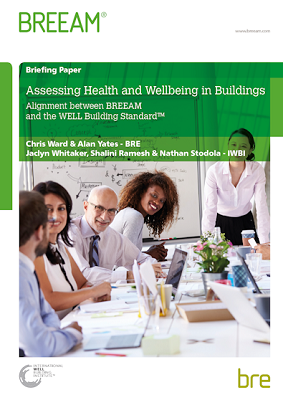Assessing health and wellbeing in buildings
In January 2018, BRE and the International WELL Building Institute pbc (IWBI™) released a new, improved briefing paper that outlines how projects may achieve both a certified BREEAM rating and WELL Certification post-occupation.
Following the 2016 announcement of an agreement between the two organisations to pursue alignments between WELL and BREEAM; the crosswalk document, Assessing Health and Wellbeing in Buildings, was first published in early-2017 to make it easier for those wishing to obtain both a certified BREEAM rating and a WELL Certified™ rating.
The document provides guidance on how the process for pursuing dual certification may be streamlined, and offers information for architects and designers to better understand the requirements and how the two standards relate. It also sets out the areas where WELL requirements are addressed by UK and/or EU regulations, and where these can be omitted from an assessment for buildings undergoing a WELL assessment in these territories.
Specific improvements and enhancements to the guidance document include instructions for projects that clarify how to use the crosswalk, minor amendments to the alignments and overlaps between the two standards, and a simplified labeling system. The new crosswalk also features useful notes and comments to clarify these alignments.
BREEAM and WELL are both evidence-based systems that have best practice, continual improvement and the interest of both the environment and people at their heart. Certification under both systems is pursued through the submission of project documentation and on-site post-occupancy performance testing.
The publication of the briefing paper comes at a time when corporations as well as the real estate industry are increasingly looking at how the built environment impacts human health as well as sustainability.
Alan Yates, BREEAM Technical Director, said: “The document will allow clients and design teams to use the same evidence in both schemes. When you need or want both certification schemes, this document will guide project teams on the most efficient way of going through the process. They won’t need to duplicate evidence or calculate things in different ways, as approximately 35 % of credits are equivalent or aligned in some way. This will ultimately reduce the burden of assessing both schemes.”
This article was originally published here on 1 Feb 2017 by BRE Buzz. It was written by Simon Guy.
--BRE Buzz
[edit] Related articles on Designing Buildings Wiki
- Are we doing the right thing? Shaping well-being into the future of our urban communities.
- BRE Buzz articles on Designing Buildings Wiki.
- BREEAM.
- BREEAM Assessor.
- Building Back Better: Health.
- Building for wellbeing.
- Building up wellbeing in construction.
- Human comfort in buildings.
- Measuring the wellbeing benefits of interior materials.
- Performance in use.
- Phobias.
- The Flourish Model to enhance wellbeing.
- WELL and BREEAM align.
- WELL Building Standard.
- Wellbeing and buildings.
- Wellbeing considerations for property managers.
Featured articles and news
The context, schemes, standards, roles and relevance of the Building Safety Act.
Retrofit 25 – What's Stopping Us?
Exhibition Opens at The Building Centre.
Types of work to existing buildings
A simple circular economy wiki breakdown with further links.
A threat to the creativity that makes London special.
How can digital twins boost profitability within construction?
The smart construction dashboard, as-built data and site changes forming an accurate digital twin.
Unlocking surplus public defence land and more to speed up the delivery of housing.
The Planning and Infrastructure Bill
An outline of the bill with a mix of reactions on potential impacts from IHBC, CIEEM, CIC, ACE and EIC.
Farnborough College Unveils its Half-house for Sustainable Construction Training.
Spring Statement 2025 with reactions from industry
Confirming previously announced funding, and welfare changes amid adjusted growth forecast.
Scottish Government responds to Grenfell report
As fund for unsafe cladding assessments is launched.
CLC and BSR process map for HRB approvals
One of the initial outputs of their weekly BSR meetings.
Architects Academy at an insulation manufacturing facility
Programme of technical engagement for aspiring designers.
Building Safety Levy technical consultation response
Details of the planned levy now due in 2026.
Great British Energy install solar on school and NHS sites
200 schools and 200 NHS sites to get solar systems, as first project of the newly formed government initiative.
600 million for 60,000 more skilled construction workers
Announced by Treasury ahead of the Spring Statement.
The restoration of the novelist’s birthplace in Eastwood.
Life Critical Fire Safety External Wall System LCFS EWS
Breaking down what is meant by this now often used term.
PAC report on the Remediation of Dangerous Cladding
Recommendations on workforce, transparency, support, insurance, funding, fraud and mismanagement.
New towns, expanded settlements and housing delivery
Modular inquiry asks if new towns and expanded settlements are an effective means of delivering housing.



























